
Baldur's Guide 3 Ranger Class Guide - Favored Enemies, subclass tips, and Feat advice
An expert hunter that's one with their hunting ground is the lot of a Ranger in Baldur's Gate 3. The signature class of some of The Forgotten Realms' most iconic characters, Rangers have long occupied a specialized niche among the martial classes for characters that exploit their relationship with the natural world as part of their approach to all things. If that sounds like a good bond to forge, keep on reading for our complete Ranger class guide. For other classes and aspects of the game, see our full slate of available Baldur's Gate 3 guides.
Before You Begin
Note that none of these points are set in stone. Build your character the way you choose, and see these notes more as suggestions than rules. For more tips, check out our Baldur's Gate 3 Character Creation guide.
This guide will also assume that you are building a custom character. Origin Characters have unique interactions and roleplaying options available thanks to their preset nature. Though there are no Ranger Origin Characters by default, you may choose The Dark Urge and build them as a Ranger. Minsc is a unique, recruitable Ranger party member.
Additionally, this guide presumes you are building a single-class character. Multiclassing into different classes as you level up is an option to gain new and useful abilities, but there’s also value in specialization. We’ll have a few multiclass suggestions for you at the end of the guide.
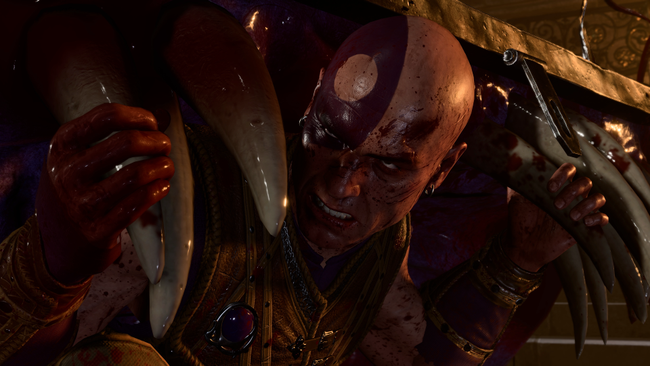
The Ranger Playstyle
If you can think of a Paladin as a midway point between a Cleric and a Fighter, a Ranger is best seen as a triangulation of sorts between the Druid, the Fighter, and the Rogue. Rangers thrive using lighter gear and weapons than a Fighter, and can operate at any distance of engagement thanks to their access to specialized ranged attack actions. The "hunting ground" metaphor is almost literal as well, as Rangers benefit from unique sets of buffs based on their Natural Explorer and Favored Enemy class features.
Rangers are expert skirmishers, with tools for most combat situations that don't involve holding the front line alone the way a Fighter, Paladin, or Barbarian might. Keep these principles in mind, and you'll find a versatile and adaptable combatant capable of handling just about anything thrown their way.
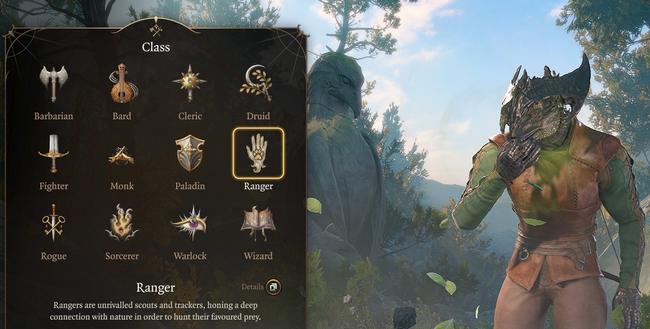
Ranger Class Features
- Key Abilities: Strength and Dexterity
- Rangers use both of the "fighting" Ability Scores as their key abilities. However, their gear focus suggests that most players are best off leaning more into Dexterity than Strength as a combat ability, the better to benefit from Finess Weapons and armor class bonuses.
- Rangers use Wisdom for their spellcasting. Consider pumping a decent Wisdom modifier to improve your Ranger's spells, but don't expect to rely on them for your damage output.
- Gear Proficiency: Light and Medium Armor, Shields, Simple and Martial Weapons.
- Rangers can use any weapon and up to medium armor, though the Ranger Knight Favored Enemy choice adds Heavy Armor proficiency.
- Skill Proficiency: At creation, Rangers can choose two skills for their proficiency. Rangers should choose skills based on their play style but can benefit from high bonuses in stats related to Athletics and Stealth.
- Athletics
- Animal Handling
- Investigation
- Nature
- Perception
- Stealth
- Survival
- Insight
- Favored Enemy: The Ranger's signature feature is the Favored Enemy, which conveys special perks designed to improve combat performance against certain categories of foes. Unlike older iterations of the Ranger, these benefits can apply to a variety of situations and don't depend specifically on fighting a favored enemy. The Ranger Knight choice can be powerful for a Strength-based melee Ranger, giving them access to more effective armor. Rangers can choose more Favored Enemy options as they level up.
- Bounty Hunter: Proficiency in Investigation, targets hit with Ensnaring Strike suffer Disadvantage on their save.
- Keeper of the Veil: Proficiency in Arcana, can cast Protection from Evil and Good.
- Mage Breaker: Proficiency in Arcana, can cast True Strike
- Ranger Knight: Proficiency in History, Heavy Armor Proficiency
- Sanctified Stalker: Proficiency in Religion and can cast Sacred Flame.
- Natural Explorer: Functioning like a Favored Enemy, but for different types of environments, Natural Explorer represents the Ranger's bond with nature, giving a bonus based on your choice. Urban Tracker will allow a Ranger with high Dexterity to replace a Rogue or Bard for the purposes of getting through locks and using Thieves' Tools. Wasteland Wanderer (Fire) makes the Ranger resistant against the most common damage type in the game. Rangers can choose more Natural Explorer options as they level up.
- Beast Tamer: Can cast Find Familiar without expending a spell slot
- Urban Tracker: Gain Proficiency in Sleight of Hand
- Wasteland Wanderer: Gain resistance to elemental damage from Cold, Fire or Poison, depending on your choice.
- Ranger Spellcasting: Rangers gain access to a handful of spells, primarily drawn from the Druid selection, and use Wisdom as their casting ability.
- Fighting Style: Rangers get access to Fighting Styles, and can pick from Archery, Defense, Dueling, and Two-Weapon Fighting. The Ranger class - or rather, one very iconic Ranger - is famous for two-weapon fighting, and the class' friendliness to enabling Dexterity-based martial builds rewards playing around with the light weapons that work best with dual-wielding. Archery is also quite powerful for Rangers in Baldur's Gate 3, with many powers applicable to ranged attacks.
- Land's Stride: Even fewer things can stop a Ranger, once they receive Land's Stride, which like the Barbarian Wildheart and Circle of the Land Druid features, prevents difficult terrain from affecting movement speed.
- Hide In Plain Sight: A feature that quite helps ranged- or ambush-focused Rangers, this gives a massive +10 bonus to Stealth checks when you stand still.
Rangers Gear Recommendations
- Rangers are natural "Dexterity Fighters", meaning they use light and Finesse-tagged melee weapons to take advantage of a high Dexterity bonus on attack rolls, as well as favoring ranged attacks. Favoring Strength as a Ranger is very possible, but will require more focused use of ability points to bring those bonuses up.
- Rangers should favor the best medium armor, light weapons, and ranged weapons they can afford. You may consider lighter armor if you have a very high dexterity bonus, or if you plan to use stealth a lot as a Ranger, as most medium armor carries penalties to Stealth.
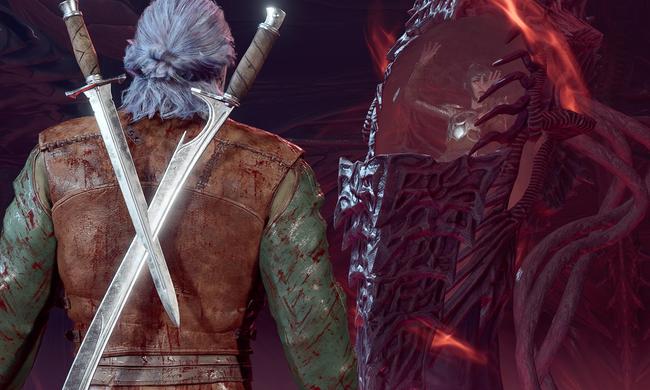
Ranger Subclasses
Rangers choose a "Conclave" as their subclass at Level 3, choosing how best to approach their task. Each Ranger subclasses leverages a different aspect of the class. The Hunter uses specialized buffs and peculiar techniques to take down the most dangerous prey in the realms. The Gloom Stalker works in the darkness, able to move undetected and deliver lethal damage to unsuspecting foes. The Beast Master draws on the Ranger's bond with nature to seek and gain the help of powerful animal companions.
Hunter
The Hunter is the "basic" Ranger, one that leans into the older interpretation of the "Favored Enemy" mechanic as one where the Ranger is particularly effective against certain categories of threat. In this case, the Hunter looks to take down "big game", including foes with a lot of HP, foes that are physically very large, or big groups of enemies.
Subclass Features
- Hunter's Prey: This is the signature feature of the Hunter, and it's essentially an extra, enhanced version of Favored Enemy. These benefits stack with Favored Enemy, too. For our money, the most broadly applicable is the Colossus Slayer.
- Colossus Slayer: Weapon attacks against a creature do extra damage if the creature is below its HP maximum once per turn.
- Giant Killer: If a large-size or larger creature attacks you and misses, you can immediately attack that creature as a reaction.
- Horde Breaker: Target two creatures standing close to each other, then attack them in quick succession.
- Defensive Tactics: Hunters gain defensive boosts that improve the Ranger's defenses in specific situations. These are all passive boosts that apply whenever they're relevant.
- Escape the Horde: Enemies disadvantaged on opportunity attacks against you
- Steel Will: Advantage on saves vs. Fear
- Multiattack Defense: When an enemy attacks, you, they take a -4 penalty on all additional attacks made against you until their next turn.
- Whirlwind Attack and Volley: Though there are two names listed here, it's effectively the same point-blank AOE attack, just with a different name depending on your held weapon.
Beast Master
The Beast Master Ranger puts their all into an animal companion. Though virtually any Ranger can gain a familiar, the bond between the Beast Master's animal companion is deeper and more meaningful than that of a typical summon, and companions can share in some of the Ranger's own statistics.
As they work on separate mechanics, a Beast Master can have both their companion and a summoned familiar deployed at the same time, making them a party unto themselves.
Subclass Features
- Ranger's Companion: The Beast Master's signature feature, this summons a beast companion to the Ranger's side to help them in quests and combat. Companions have their own stats and unique combat qualities.
- Bear: A Bear can attack with its bear claws and has prodigious health and a high initial armor class. It can taunt enemies, drawing their attention and tanking for the Ranger and party.
- Boar: Boars can attack wth their tusks and charge forward, dealing damage to hostile creatures and potentially knocking them prone.
- Giant Spider: Spiders have a very long jump distance and height, and can poison enemies with a biting action. They can also shoot a web, covering targets in the area and immobilizing them. The web is also flammable, hint hint.
- Raven: Your very own medieval scouting drone, the Raven can fly, deal piercing damage, and blind enemies with a well-aimed claw strike.
- Wolf: Beside you there is one wolf. It can knock the target prone with its bite and does piercing damage.
- Companion's Bond: Ranger companions benefit more from their bond with the Ranger than a standard familiar. The Ranger's Proficiency Bonus is added to the Companion's Armor Class and damage rolls.
- Exceptional Training: Companions become even more useful in combat, learning to use Dash, Disengage, and Help as bonus actions.
- Bestial Fury: Companions even gain extra attacks, like the Ranger.
Gloom Stalker
The Gloom Stalker Ranger is the third of the "ninja" subclasses beside the Rogue Assassin and Way of Shadow Monk. The Gloom Stalker lives to make the first move, ambushing enemies from the shadows and gaining considerable benefits in the first round of combat. Unlike an Assassin, though, a Gloom Stalker is more the type to quickly start (and end) a fight in the darkness, rather than returning to hiding.
Rangers belonging to races that lack Darkvision can also gain this by taking the Gloom Stalker subclass.
Subclass Features
- Dread Ambusher: The Gloom Stalker is built to take the first action at the opening of an engagement. They gain bonuses to their Initiative roll, and on the first turn of combat, they get to make an extra attack action with increased movement speed and damage.
- Dread Ambushers also gain the ability to enter Stealth as a bonus action. Provided they stick to the darkness and avoid sight lines, they can keep from being detected. They don't have any particular damage bonus, though, unlike Rogues.
- Superior Darkvision: Gloom Stalkers gain the ability to see in the dark for up to 24m. This feature is typically restricted to Underdark-native races like the Deep Gnome and Drow.
- Umbral Shroud: If hiding isn't enough, a Gloom Stalker can simply become invisible magically.
- Ranger Spells: Gloom Stalkers get some stealth, control, and mobility-focused spells to add to their spellbooks, too.
- Disguise Self, Misty Step, Fear
- Iron Mind: Gloom Stalkers gain proficiency in Wisdom and Intelligence saving throws. Proficiency bonuses are always welcome, but at least in the case of Intelligence saves, the impact is likely to be muted in most cases considering a Ranger's ideal ability allocation.
- Stalker's Flurry: Make a Weapon attack for free when missing with a weapon attack. Technically "situational", but whiffing weapon attacks is the pits, so it's great to get a free do-over.
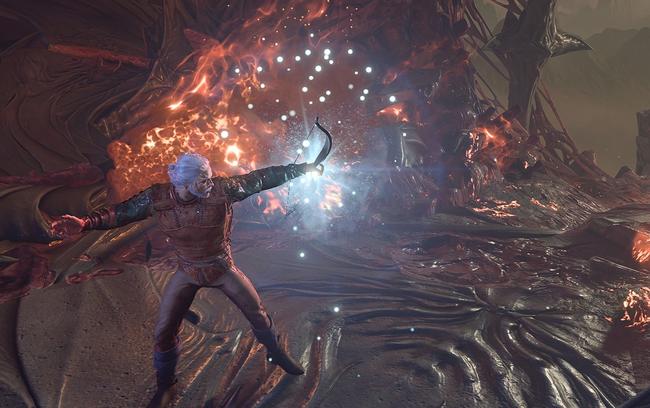
Ranger Level Progression
These are the class features you’ll get as you level up as a Ranger. The maximum level cap in Baldur’s Gate 3 at launch is Level 12. Use this to see what you’ll get at each level and plan accordingly, in case you wish to multiclass.
This guide will also highlight class features you gain based on your subclass choice. For more detailed info about the subclasses, see the sections above. Features gained by a Subclass are labeled with the Subclass name.
Note: Unlabeled benefits are “standard” class features and common to all subclasses.
Level 1
- HP: 10 HP + Constitution Modifier, gaining minimum of 6 HP + Con modifier per level.
- Favored Enemy
- Natural Explorer
Level 2
- Fighting Style: Choose 1 from Archery, Defense, Two-Weapon Fighting, Dueling.dvantage on Attack Rolls against fiends
- Ranger Spellcasting
- 2 Level 1 spell slots
Level 3
- Ranger Spells
- +1 Level 1 spell slots (3 total)
- Ranger Subclass: Choose 1 from Beast Master, Gloom Stalker, Hunter
- Hunter: Hunter's Prey
- Beast Master: Ranger's Companion
- Gloom Stalker: Dread Ambusher, Superior Darkvision, Umbral Shroud, Disguise Self spell
Level 4
- Feat Selection: Can pick a Feat from All Classes Feat list. While any class at level 4 can pick many of the Feats, not all will be relevant to the class. You can also choose an ability improvement to boost a bonus or eliminate a penalty. Check out our full Feats guide for more advice on Ranger-appropriate Feats.
- Recommended Ranger Feats:
- Ability Improvement
- Athlete
- Charger
- Defensive Duelist
- Dual Wielder
- Dungeon Delver
- Durable
- Lucky
- Mobile
- Skilled
- Sharpshooter
- Tough
- Weapon Master
- Recommended Ranger Feats:
Level 5
- Extra Attack: Can make an additional free attack when making an unarmed or weapon attack.
- Ranger Spells
- +1 Level 1 spell slots (4 total)
- 2 Level 2 spell slots
- Beast Master: Companion's Bond
- Gloom Stalker: Misty Step spell
Level 6
- Favored Enemy: +1 Favored Enemy
- Natural Explorer: +1 Natural Explorer terrain
Level 7
- Ranger Spells
- +1 Level 2 spell slots (3 total)
- Hunter: Defensive Tactics
- Beast Master: Exceptional Training
- Gloom Stalker: Iron Mind
Level 8
- Feat Selection: Can pick a Feat from All Classes Feat list
- Land's Stride: Unaffected by difficult terrain
Level 9
- Ranger Spells
- 2 Level 3 spell slots
- Gloom Stalker: Fear spell
Level 10
- Hide in Plain Sight: +10 to stealth checks when standing still
- Favored Enemy: +1 Favored Enemy (3 total)
- Natural Explorer: +1 Natural Explorer terrain (3 total)
Level 11
- Ranger Spells
- +1 Level 3 spell slots (3 total)
- Hunter: Volley and Whirlwind Attack: Point-blank AOE attack
- Beast Master: Bestial Fury
- Gloom Stalker: Stalker's Flurry
Level 12
- Feat Selection: Can pick a Feat from All Classes Feat list
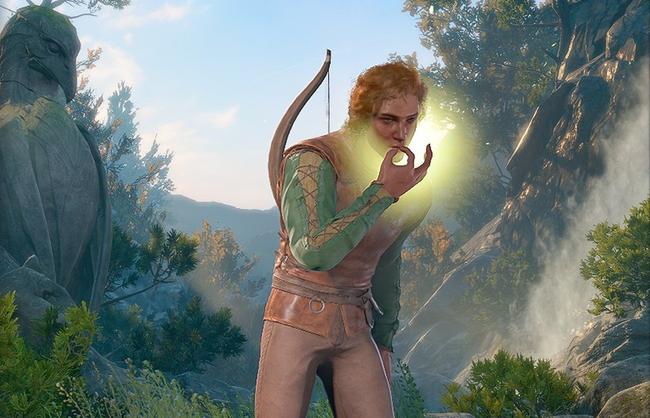
Multiclass Rangers
Rangers can benefit from multiclassing if choices are made in the mid and late-game. Some of the Ranger subclass and class features added after levels 6 and 7 are less essential for build optimization, making the mid-to-late game an ideal breaking point to start mixing in other classes.
Rangers of all stripes synergize very well with the Rogue. Rangers generally favor high dexterity as their combat ability, matching the Rogue's forte and skill disposition. Levels in Rogue grant access to perks like Sneak Attack, Cunning Action, and additional skill proficiencies. In fact, many multiclass Ranger/Rogue builds start the game as a Rogue, taking advantage of the Ranger and Rogue's shared equipment pool and initial skill boosts, then leaning into the Ranger's combat expertise later. This is a little less applicable in Baldur's Gate 3, seeing as respeccing and walking back class decisions is easier than standard Dungeons & Dragons.
Rangers can also pick up a level or two of Fighter to expand their armor and weapon options. This is a favorable choice for a Ranger that wants to build up their Strength score, use heavy armor, and rock big weapons like greatswords.
Rangers who want to cast more spells or find a reason to use their Wisdom bonuses can pick up a level in Cleric. The Nature domain synergizes with the Ranger's existing spell selection, and offers useful benefits like combat cantrips that use the Wisdom score instead of intelligence.
Monk is a popular Dexterity martial class that a Ranger can benefit from taking up. Blending a Monk's self-sufficient bonuses and a Ranger's prowess at ranged attacks can result in a light- or unarmored warrior that's effective at any distance.
Druid can be a valid choice for a Ranger to multiclass into, but there's also a lot of overlap in the kits of the two classes, so much so that the benefits become unclear. If you want to spellcast as a druid, better to take up druid as the main class. Druids also have their own options for becoming an effective close-range fighter, so picking Ranger can seem redundant.